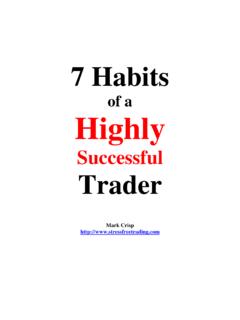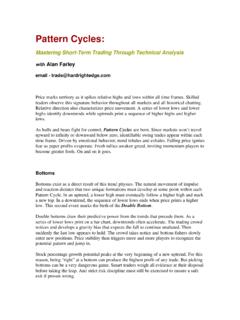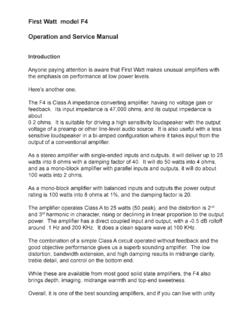Transcription of How To Read Charts Like A Pro - Learn How to …
1 How To read Charts like A ProYour guide to reading stock Charts !Courtesy of may distribute this book FREELY or use it as part of a commercial package as long as this page and notices are left in content of this e-Book is not warranted for correctness, and isused by the reader at his or her own will. No warranty is given for thecontent of this Charts courtesy of: :The information contained within this e-book is for education only, and the authors hold no responsibility to the accuracy or reliability of the information contained therein. Past performance, is not indicative of future success. All trades involve risk, which includes loss of all capital, and a professional advisor should be consulted prior to any major financial Of , Trends, and WavesChart AnalysisResourcesTips2 How to read Stock ChartsIntroductionMake no mistake about it.
2 Reading Charts is an art form that can be mastered! There are many factors on a chart that go into making trade decisions. You have to be able to analyze all of these factors and come to a conclusion about whether or not to risk your hard earned money on a trade. This is what separates the novice trader from the are several things on a chart that make it worthy of trading. The questions that you want to ask yourself about the chart are: What stage is this stock in? Is this stock in and uptrend or a downtrend? Is the stock at the beginning, middle, or end of the trend? How strong is the trend? Where are the trend lines? What wave is this stock in? What do the moving averages tell me? Was there a breakout recently? Is the chart "smooth" or "sloppy"? Are there any chart patterns?3 Are there wide range candles in the direction of the trend?
3 Are there any gaps in the direction of the trend? Are professionals selling strength or buying weakness? Where are the support and resistance areas? Is this stock at a Fibonacci level? What does volume tell me?I know it seems like a lot of information to try and keep track of but all of the above questions are essential to chart reading mastery! Now, print out that page of questions and keep it handy next to your computer. Make several copies so that you can check off and make notes as you analyze your next chart . Go ahead, I'll it printed out? Great! Now you won't forget anything important when it's time to analyze a chart for your next trade. In the heat of battle, when emotions are running high, it is very easy to forget to look for some of the most basic things on a chart . I've done it. That is, until I made this list!Ok, now let's go through the list one by one to make sure that you know how to answer the questions correctly.
4 Don't worry, with practice, you will not even need to think about these things. It will become will be able to read Charts with lightning fast speed. In just a couple of seconds you will be able to glance at a chart and know all the answers to the questions , Trends, and WavesDirectionOk, let's looks at an example chart ! This stock broke out through a consolidation in July andnow it is in a nice strong trend. The green arrow is the day on whichwe see this stock. So, what questions can we answer just fromglancing at this chart ?This stock is in stage remember the stages right? Stage one is a consolidation, stagetwo is an uptrend, stage three is another consolidation, and stage fouris a downtrend. This stock was in a stage one in July but at the end ofJuly, it broke out into a stage two. It is currently still in a stage stock is in an is the easy part.
5 If a stock is heading toward the upper rightcorner of a chart then it is in an uptrend! For some reason, this tends5to elude some stock is near the middle or end of the do we know that? The breakout signals the start of the trend. There has already been one significant pullback. Had we bought stock on the first pullback, then we would have concluded that we are at the beginning of the trend. But since this is the second pullback, then we know that this trend may not last much stock is in a strong ADX indicator (not shown) is near 30 which we consider to be a fairly strong trend. The higher the ADX, the stronger the trend. This stock is at the lower trend line. You can see by the thick green line that this stock has hit the lower trend line. You can draw the trend lines in manually, but after you have been trading for awhile, you will not need to draw them.
6 You will be able to see them stock is in the fourth Elliott Wave theory, a stock goes through 5 waves in an uptrend. In the chart above, the first wave after the breakout is wave 1. The first pullback is wave two, the next wave up to $ is wave three, and the pullback that we are in now is wave four. There is one more wave to go!ConclusionNow we have identified that the possible future direction of this stock is up. Nothing is ever certain in the stock market! However, by looking at this chart we can be certain that the probabilities are on our side for a continued move to the you finish reading this book, go through some Charts and try to identify the various factors mentioned above. Just understanding the nature of stocks and the different stages, trends and waves that all stocks go through will greatly improve you trading.
7 Soon, all of this direction analysis will become second nature. You won't even have to 6think about not done yet! Go on to the next AnalysisPricePrice, as interpreted by candles, is the most important factor toconsider on a chart . Put away the technical indicators. You do notneed them. Technical indicators serve one purpose to confusenovice traders! There isn't anything on a chart that can be learnedfrom them. Everything you need to know is right in front of you in thecandles!Ok, let's go back to our chart example:There are some very significant things happening on this chart . Doyou see them? You will in a continue answering moving averages are lined want the 10 SMA above the 30 EMA and we also want there to beplenty of space in between the two moving averages. This creates the8 Traders Action Zone (TAZ) that we can trade in.
8 If the movingaverages move too close together, then a trading range or basingpattern will likely develop. We don't want that!There was a breakout is good! We want to buy a pullback as close as possible to abreakout as we can. Why? We want to know that there is interest in astock. Remember that institutional traders have to accumulate sharesover time. They can't buy tons of shares all at once. They have tobuy a little at a time. By looking for breakouts, we can expect them tohave to buy more in the future. This will propel the stock is a smooth don't want to trade stocks that are whipping around everywhere!That is a good way to get stopped out on trades. This stock is in asmooth uptrend that can be traded with confidence, and without fearof getting shaken out of the significant chart this example, there aren't any significant chart patterns.
9 This isfine. You don't need any kind of a chart pattern like a cup and handlepattern, or a triangle to trade a stock. You do, however, want to beable to identify them when they are there. This could add someweight to the setup and may make us favor one trade over are wide range candles in the direction of the how at the end of August there are three wide range candles thatclose near the top of their range? There was also a wide range candleon the breakout in July. This is very significant! In fact it may be oneof the most significant things on the chart . Stocks tend to move in thedirection of wide range is one significant is only one significant gap to the upside on the breakout in , we would like to see more. A better case scenario would be if9there was a more recent gap. Why? Because stocks tend to move inthe direction of gaps!
10 Be careful though. After three or more gaps, astock can become overbought and may not continue to move are buying do we know this? We know by looking for "tails" or "shadows" atthe bottom of the candles. On the sixth of September there is a tail,and on this day (green arrow) there is a tail. This is very significant!You want to see that the big players are coming in to support thestock. You want them to protect you from any downside stock is at stock has pulled back to a prior high made in the middle ofAugust. This is identified by the red/green support line drawn on thechart. When a stock pulls back to a prior high it is known as minorsupport. It is still a significant support area, just not as significant asif it pulled back to a prior low. For example, if the stock pulled back tothe prior low at $ (see chart ), then it would be major , notice how the lower trend line and the support line convergeinto one right at today's candle (green arrow).













